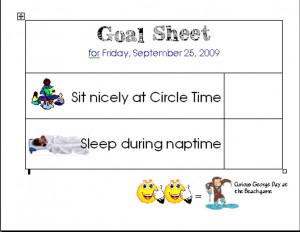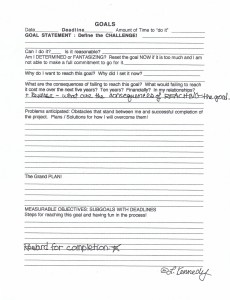Let’s settle down and talk about your goals and how to make achieving them easier. If the idea of a work-sheet makes you cringe, take a look at the first sample. You could handle that, yes? If you liked to play the Curious George game, you’d be motivated by this highly visual goal sheet. The fun of pressing down a smiley faced sticker would motivate me to “Sit nicely at Circle Time”! 
What are the basic elements that make goal setting effective?

Double click and print from the enlarged image. Fill it out and make your project HAPPEN! Share your experiences in the comments section.
1. You need to be specific! You can’t think that wishing you could paint a masterpiece is a goal. An example of specific: “Publish a blog post on Goal Worksheets before noon.”
2. Include a deadline. Otherwise, you can put it off forever. Deadlines give you the adrenaline rush needed to push through blocks. Think of goal setting as a game you are playing with yourself – if the goal is right, it will become a game you very much want (and expect) to win.
3. Be realistic. If it is too hard, you’ll give up and be discouraged about setting future goals. You can always ramp it up a notch for the next goal. Getting the painting you’re working on in the Metropolitan Museum by December isn’t realistic (unless you are going to carry it in under your coat and walk around with it for a few hours just to technically meet the goal) . Realistic goals: “I will finish this piece and show it to six different people by Dec. 15” or “By the end of the month I will have finished and framed this painting” or “Sit quietly at Circle Time”.
TIP: If the goal you are thinking about is big, once you break it into sub-goals, you can give each of the sub-goals it’s own worksheet.
Once you have those three elements, it helps to have a process that you can go through to sort out issues that might come up. The steps I take are in the GOALS worksheet that you can print and use. Better yet, make your own goal sheet and tailor it to your specific needs. I made this one decades ago and still use it. I’d like to redesign it, but that’s not a goal as it doesn’t have a deadline.
